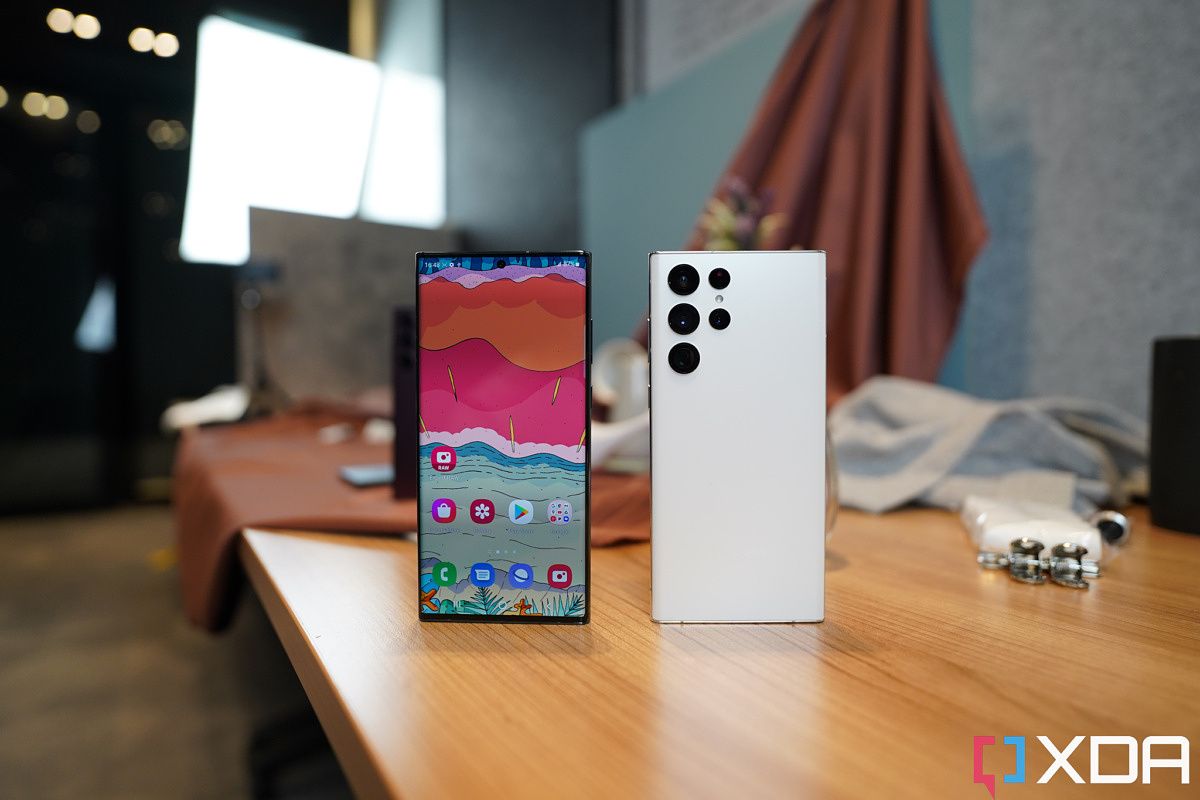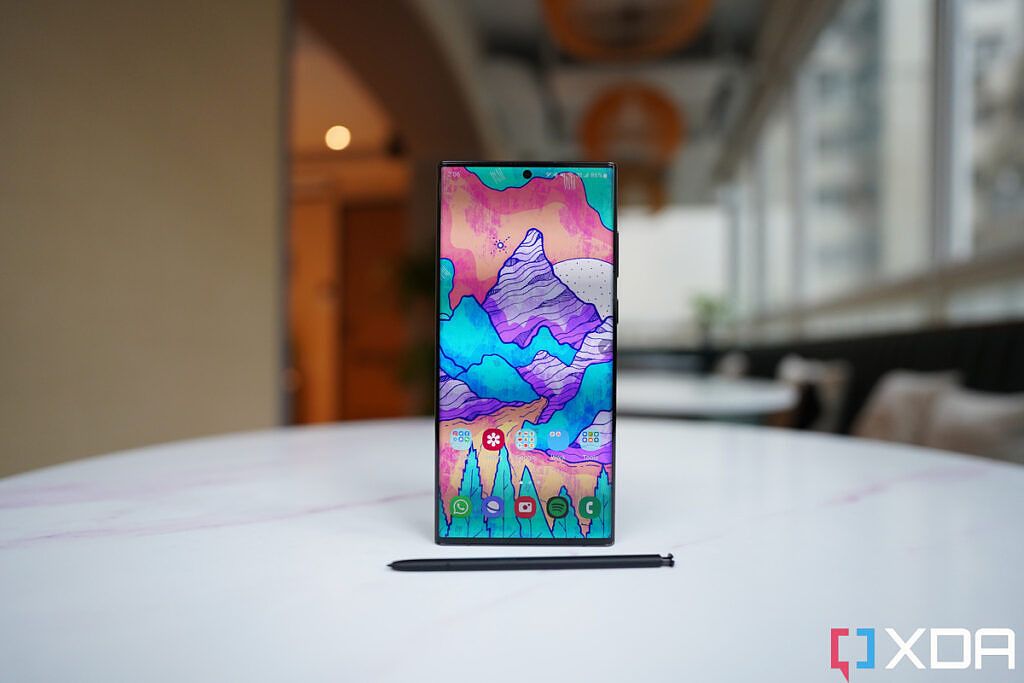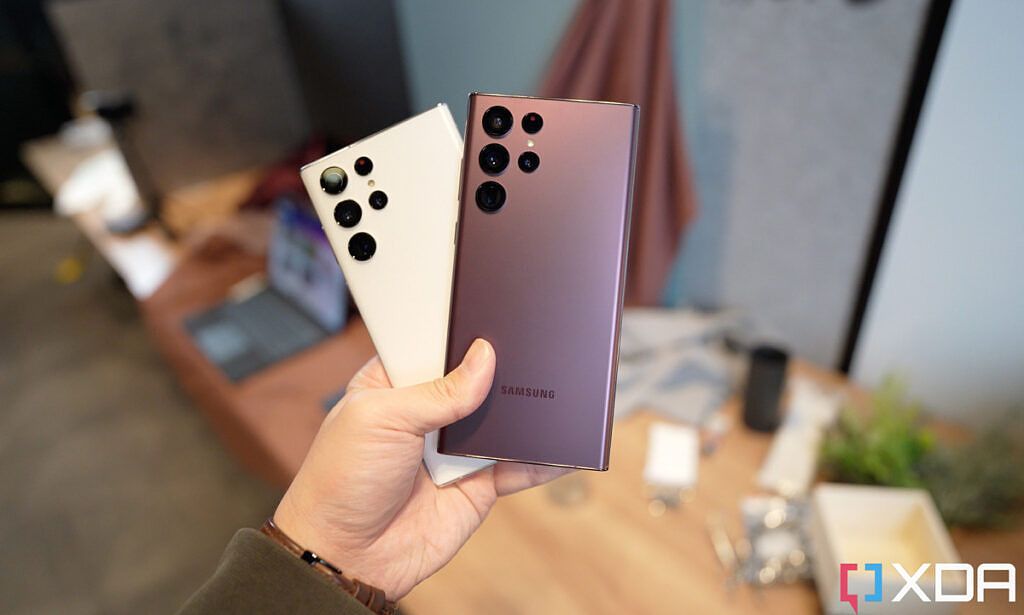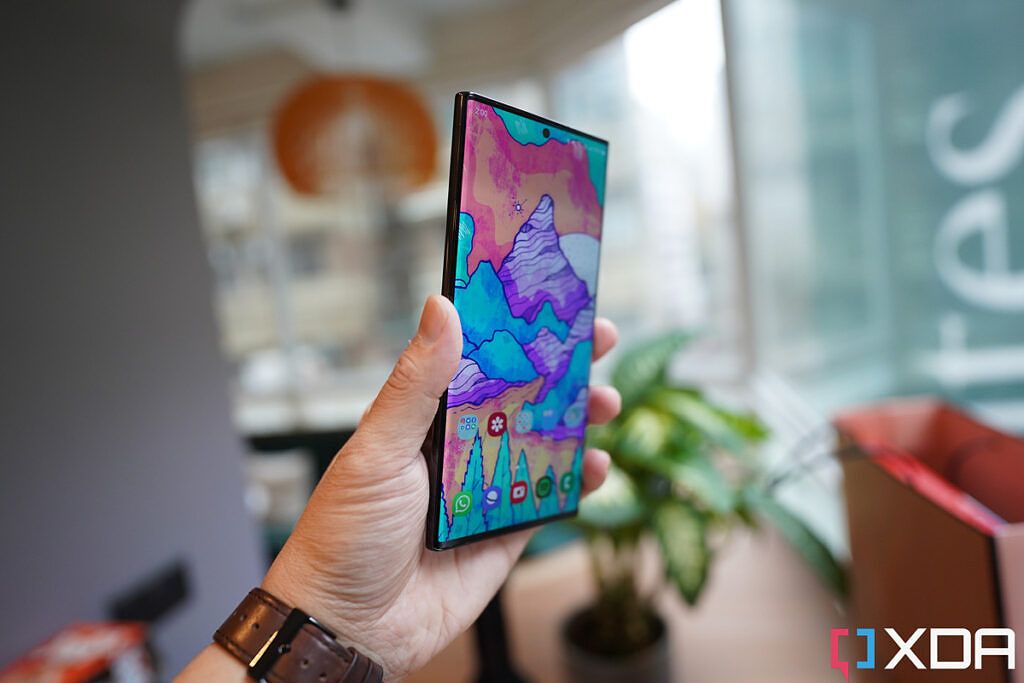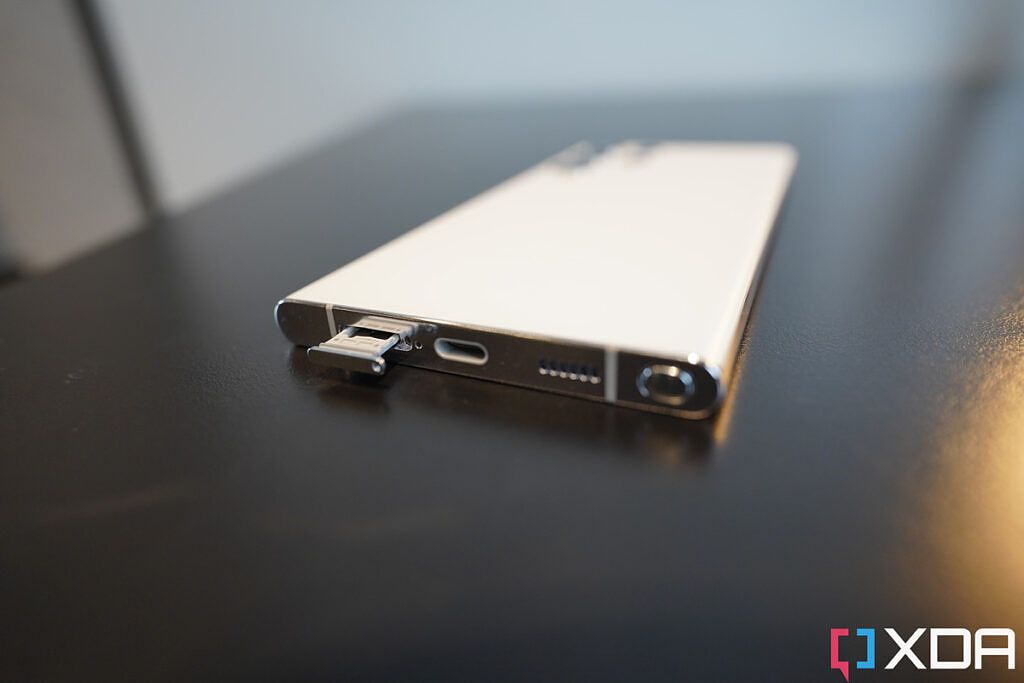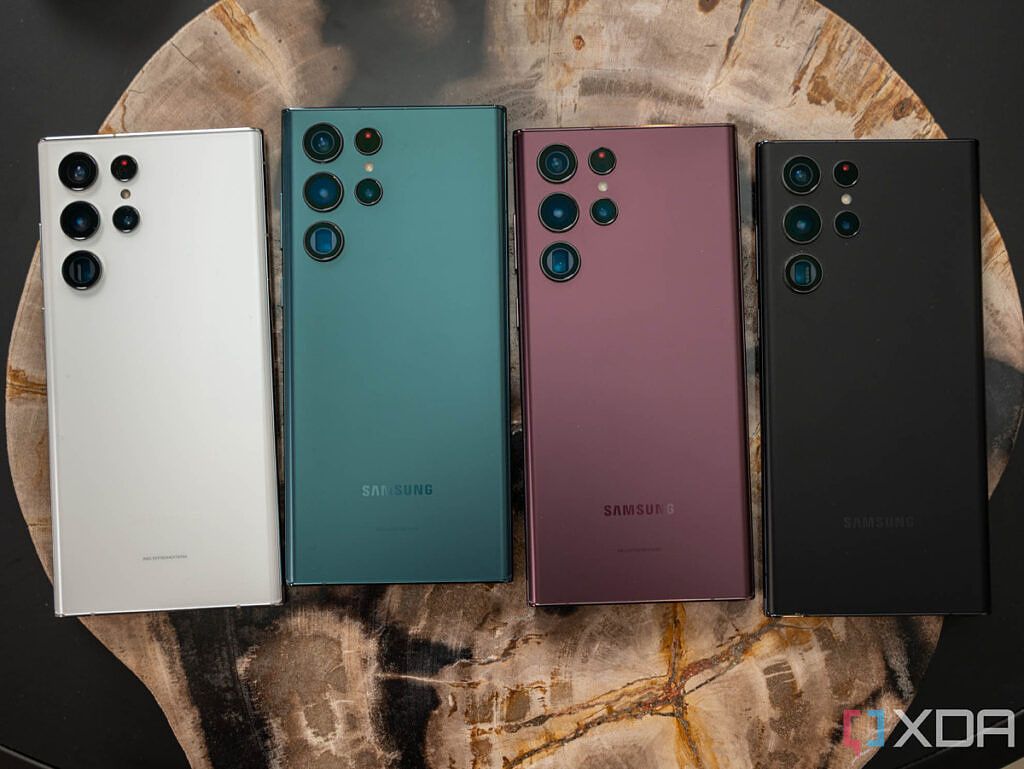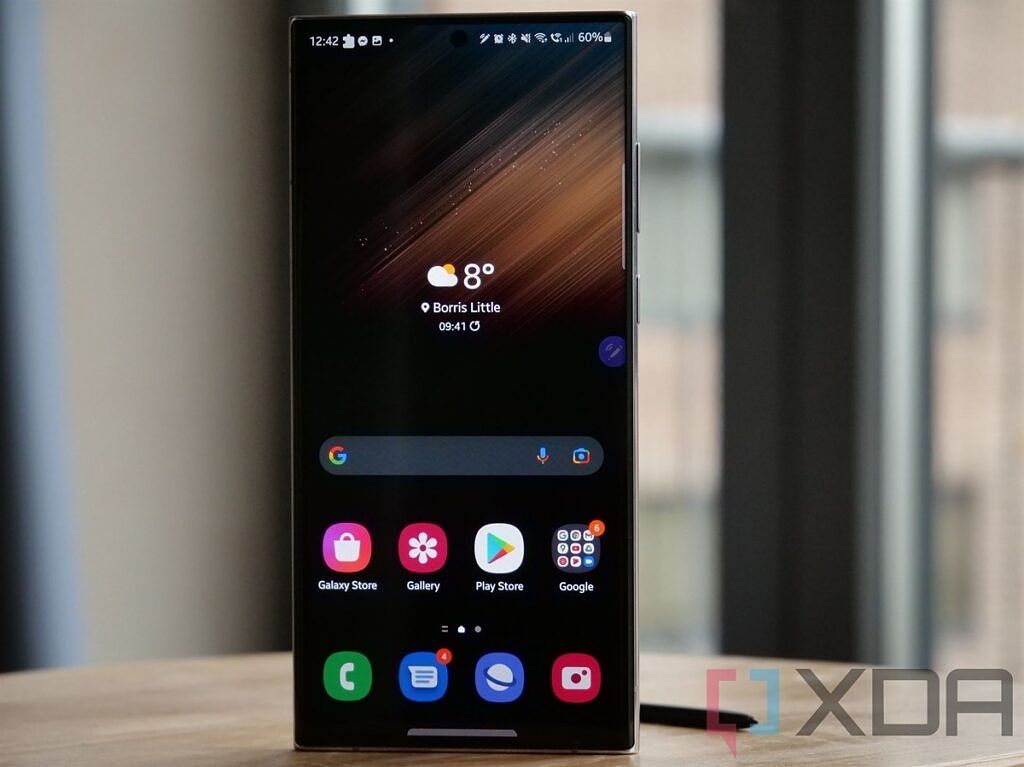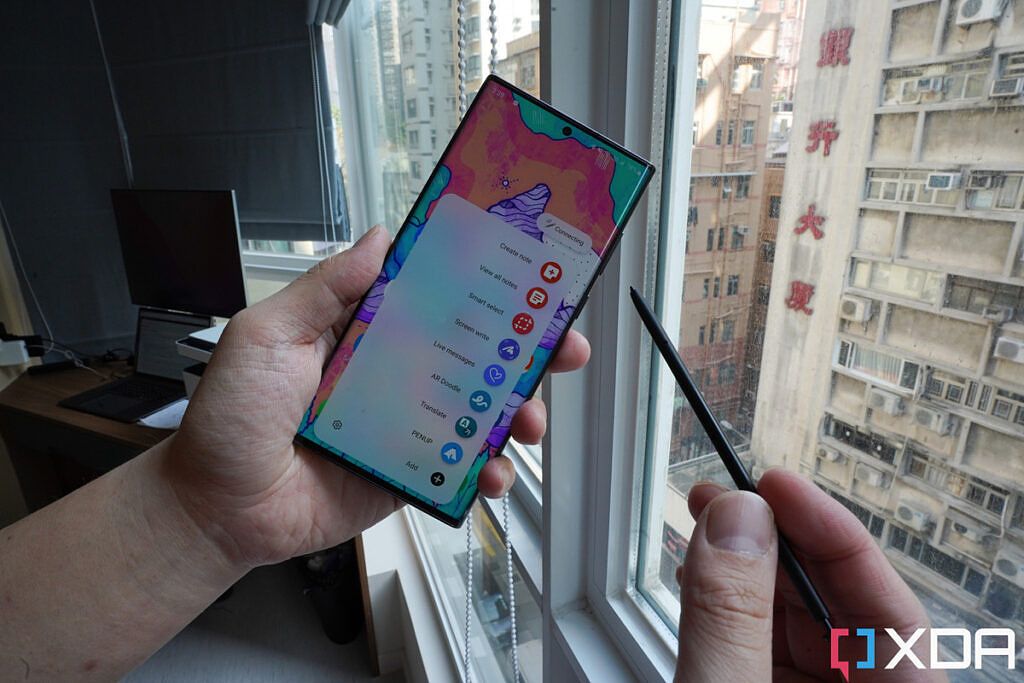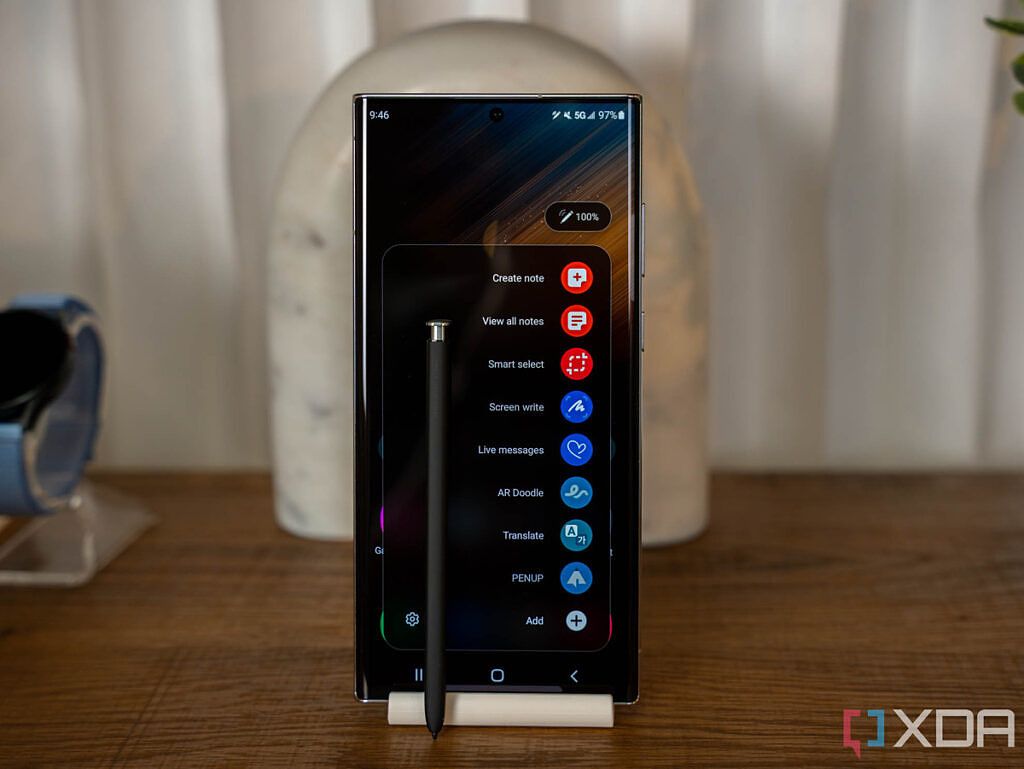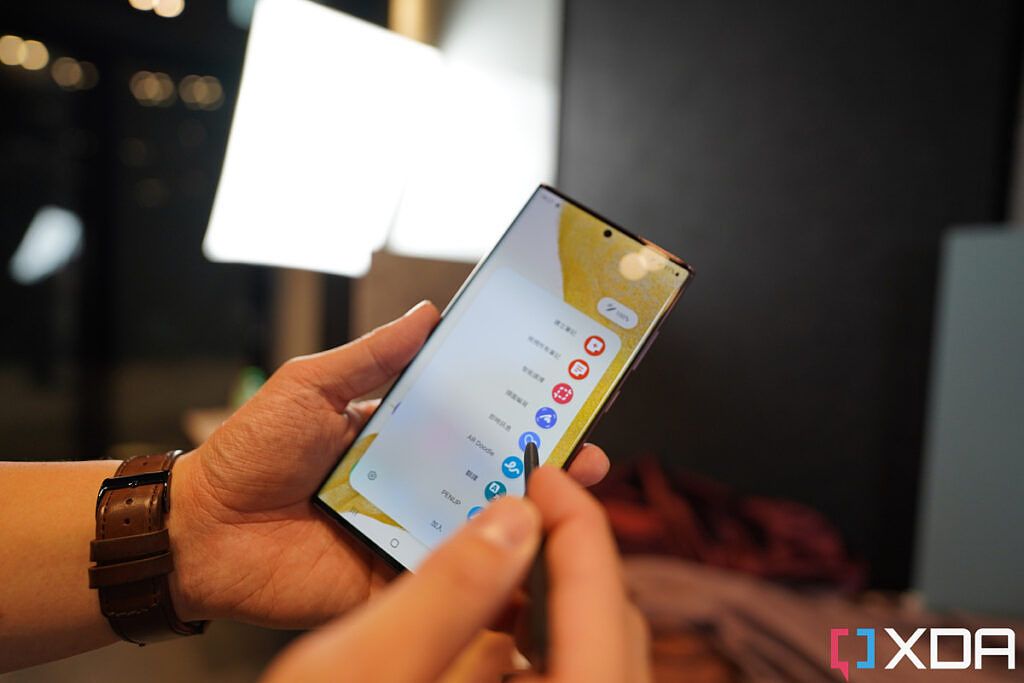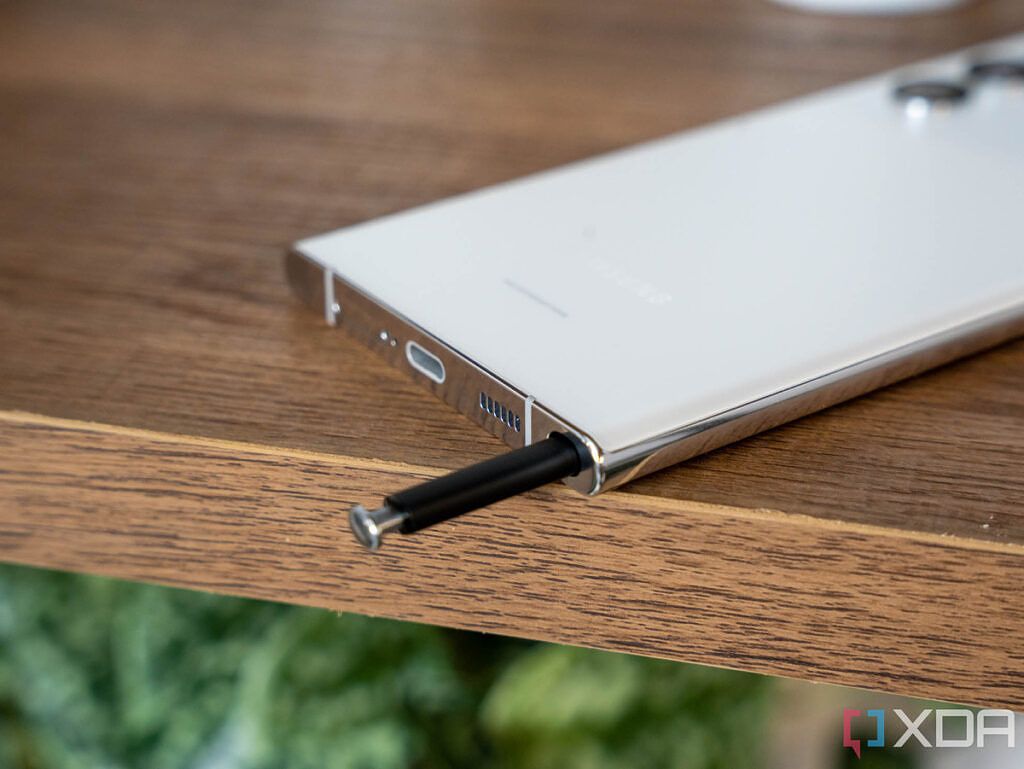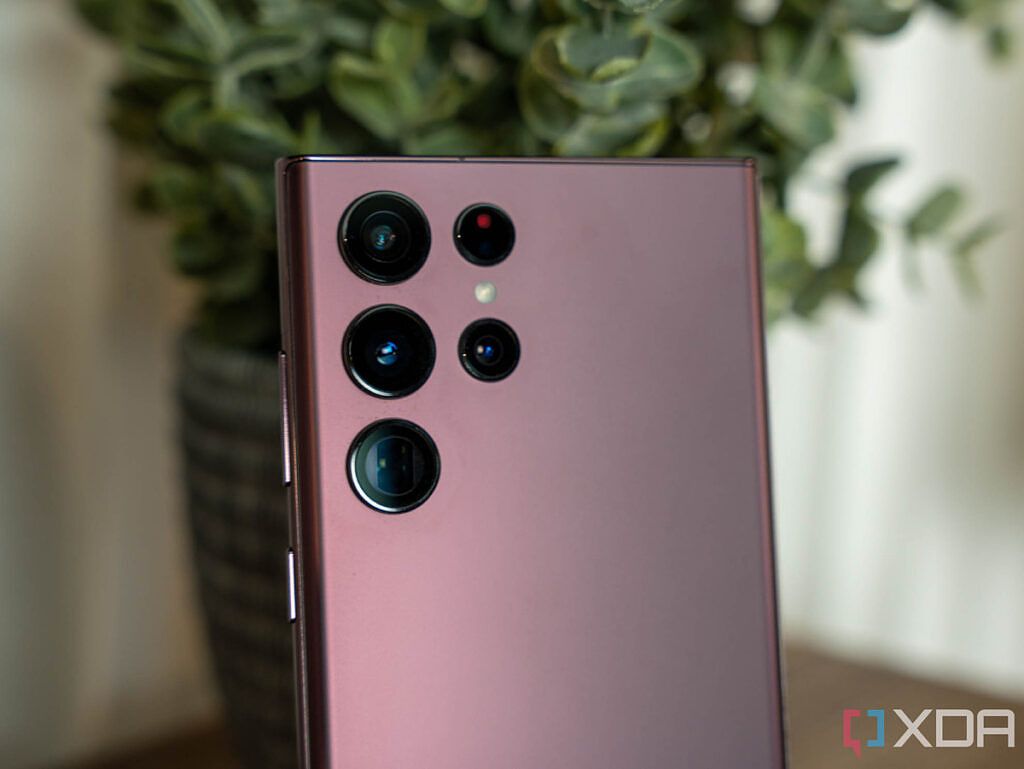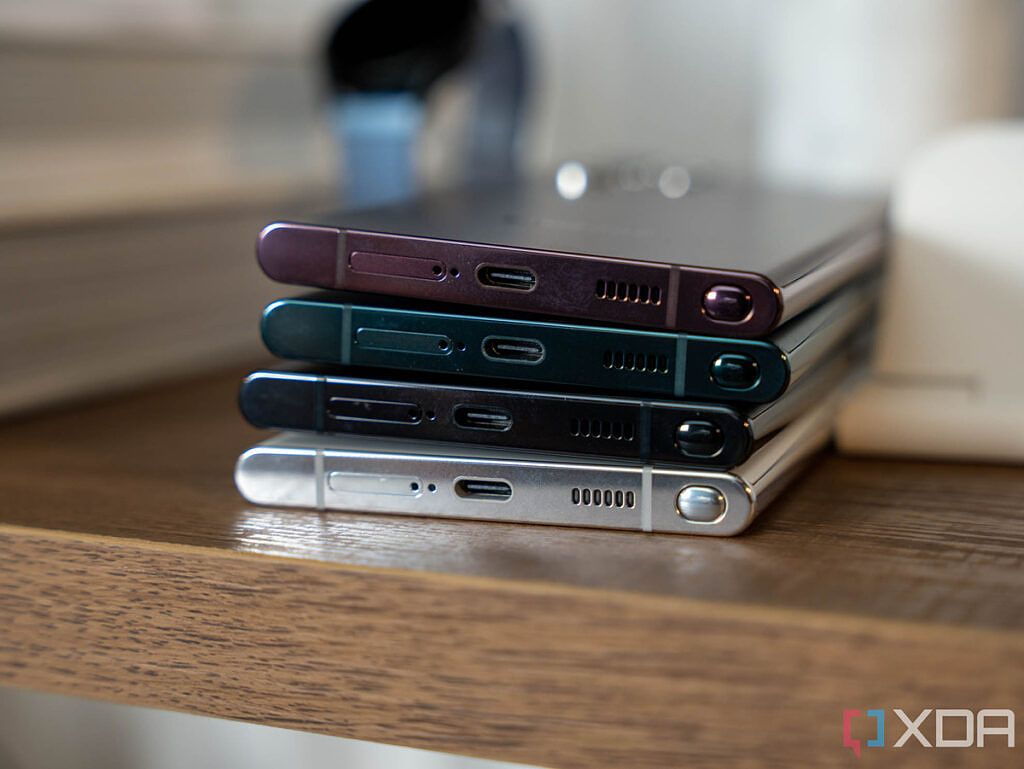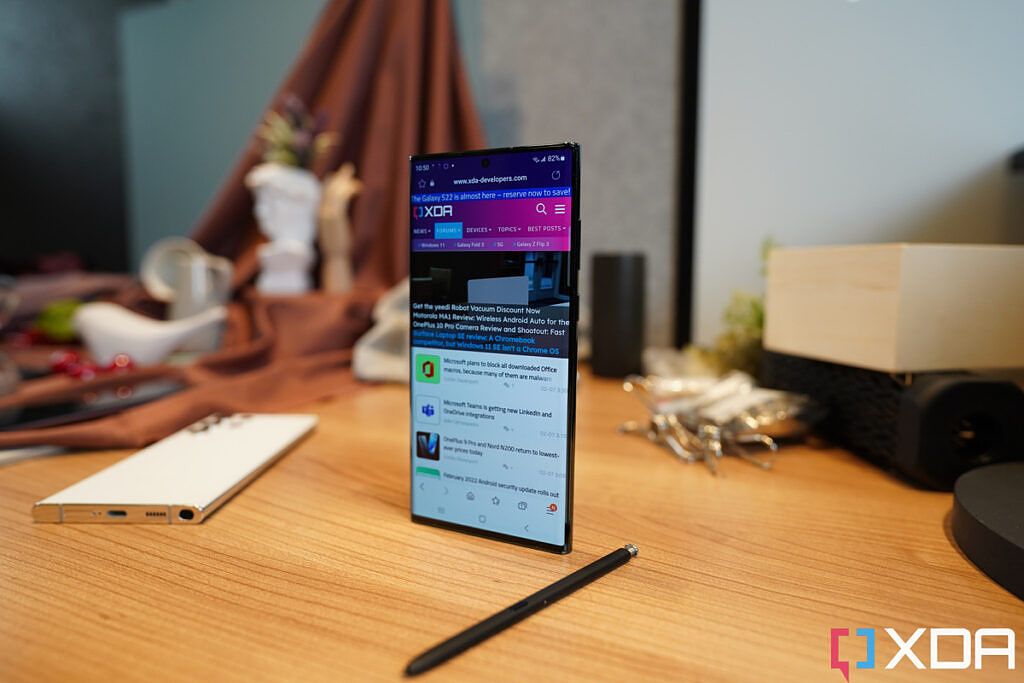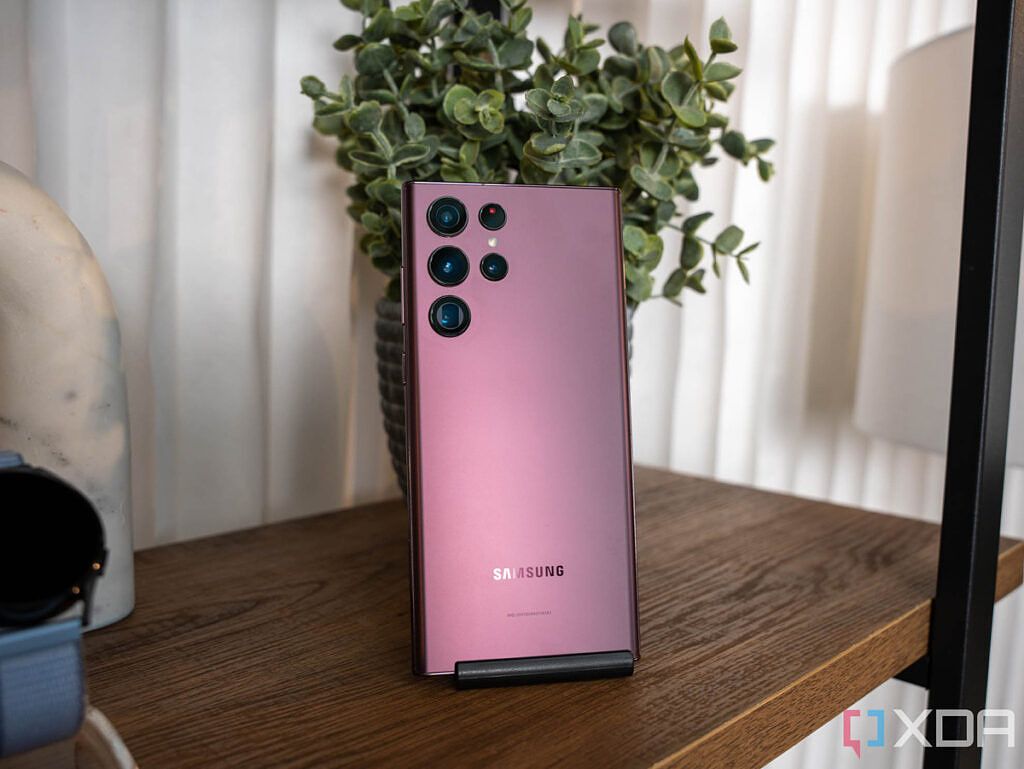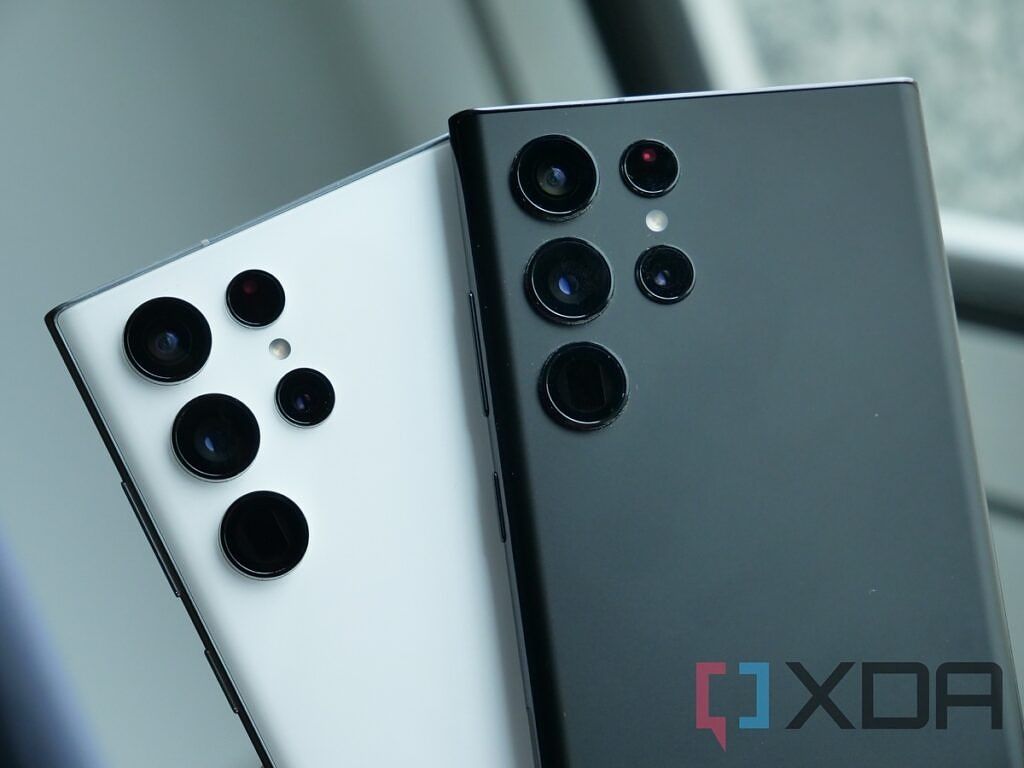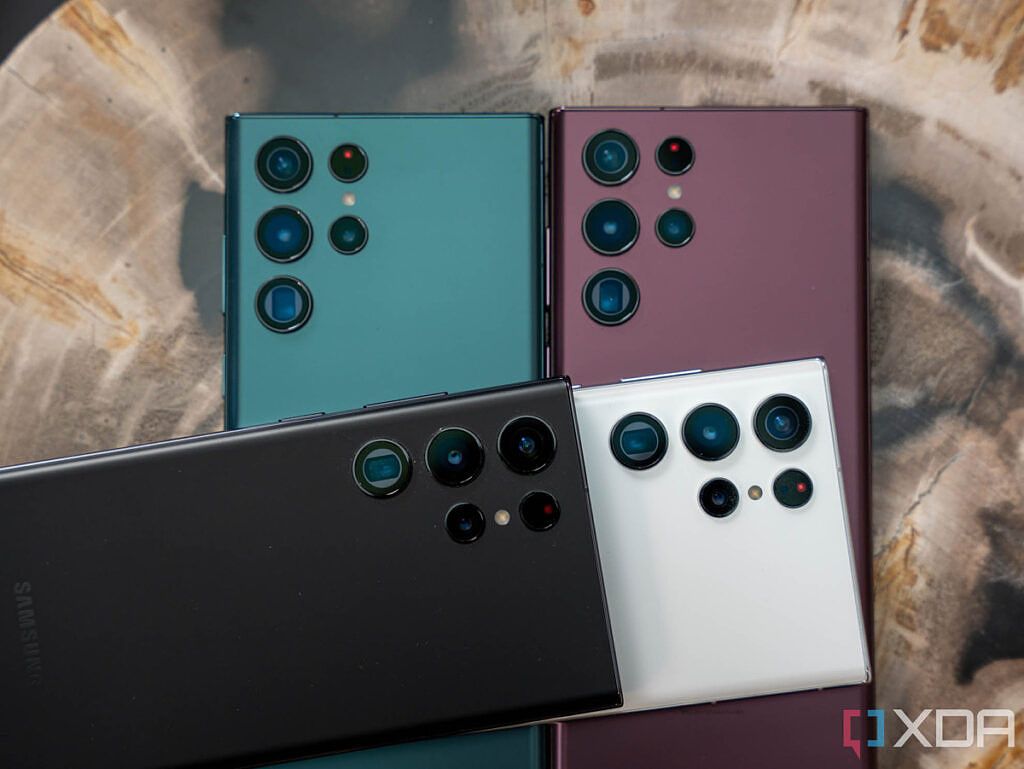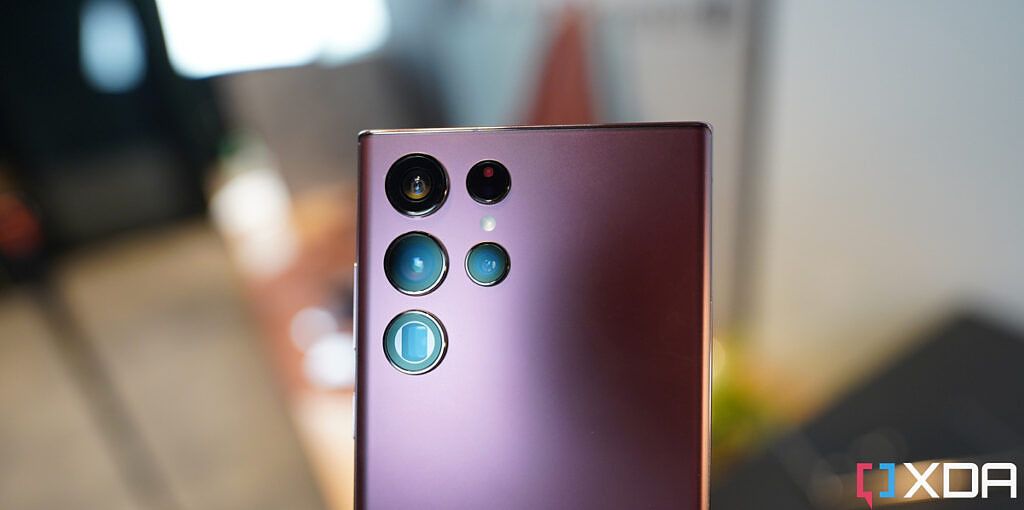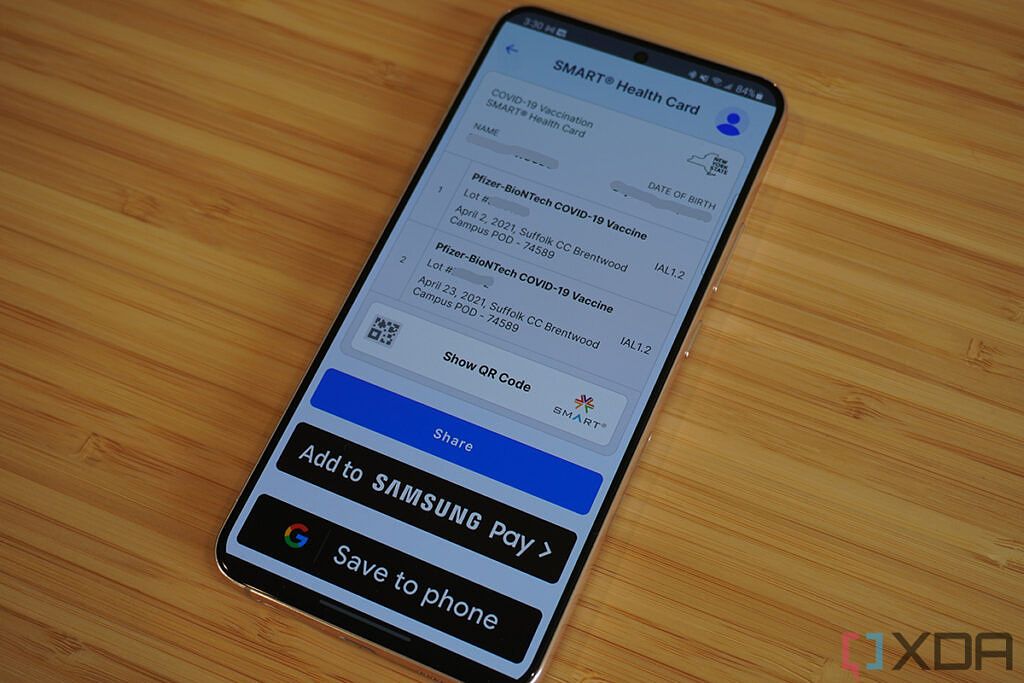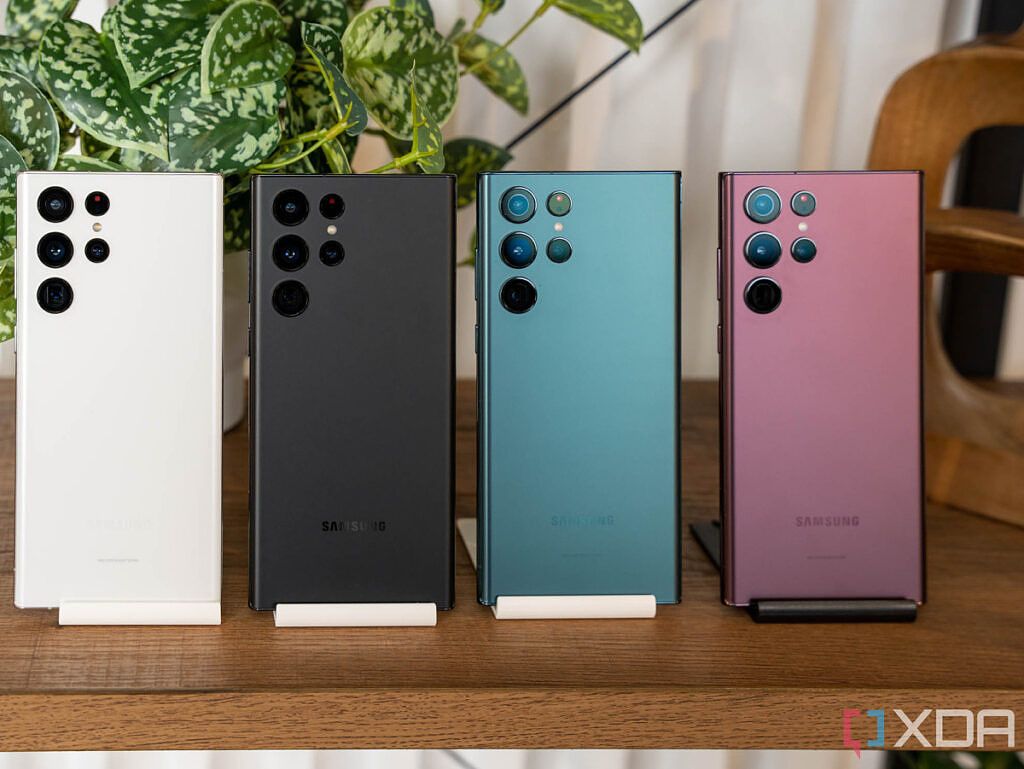The Galaxy S22 Ultra is Samsung’s newest flagship, but it’s more representative of the Galaxy Note than it is of the Galaxy S lineup. In many ways, the Galaxy S22 Ultra is the device that any Galaxy Note fan has been waiting for as it combines the very best of Samsung’s traditional smartphone lineup into a device that has it all. And as Samsung has confirmed, moving forward, the Note line will be represented by the S Ultra line, and that makes a lot of sense.
The Ultra range of the Galaxy S has always offered the best camera that Samsung has, yet the Galaxy Note 20 Ultra didn’t live up to this billing. Instead, Samsung opted to focus on productivity. With the Galaxy S22 Ultra, you now have the very best of Samsung in several areas such as performance, camera, display, battery, and even software, which was once the company’s weakness. Adding the S Pen to the Galaxy S series was a natural progression.
The Galaxy S22 Ultra is the best phone for almost everybody and nothing else comes close.
The Galaxy S22 Ultra isn’t a phone for everyone, but it’s the best phone for almost everybody. It’s big and heavy, even though it does feel much lighter than the Galaxy S21 Ultra which weighs the same but is top-heavy, versus the even weight distribution in the Galaxy S22 Ultra. The curved screens aren’t for everyone, and if you’re in a region where you get the Exynos flavor, there are plenty of performance concerns that aren’t present in the Snapdragon version I’ve been testing.
These aside, the Galaxy S22 Ultra is quite easily the best traditional Samsung smartphone ever made and the camera is so good, I’m dropping my Galaxy Z Fold 3 in favor of it. If you choose to buy the Galaxy S22 Ultra, it’s definitely a decision you won’t regret, but if the size, weight, or heft aren’t for you, the Galaxy S22 Plus is easily the best alternative you can buy right now.
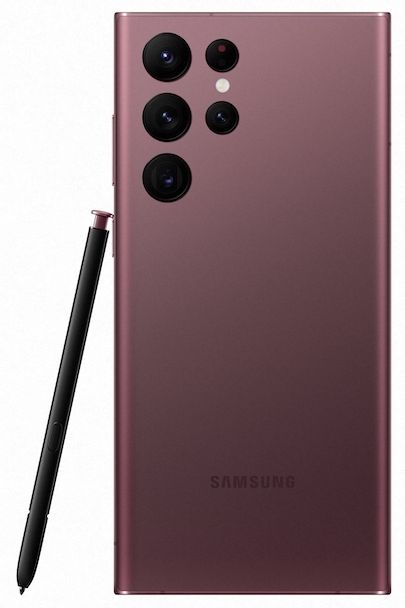
Samsung Galaxy S22 Ultra
The Galaxy S22 Ultra takes a very good phone from last year, and makes a few tweaks. The result is the best traditional smartphone that Samsung has ever made. It’s so good that everyone that can buy one should buy one.
Navigate this review:
- Samsung Galaxy S22 Ultra: Pricing and availability
- Samsung Galaxy S22 Ultra: Specs
- Noteworthy design in many ways
- The best display gets even better
- Finally, a proper S-Pen in the Galaxy S
- Incredible cameras that are nearly flawless
- All the hardware you could need
- The battery charges fast and lasts all-day
- Top-notch performance if you have the Snapdragon
- OneUI 4.1 and Android 12 are smooth and sleek
- Should you buy the Samsung Galaxy S22 Ultra?
Galaxy S22 Ultra: Price & Availability
- Starts at $1199 in the US for the version with 8GB of RAM and 128GB of storage
- Free storage upgrade if you pre-ordered, otherwise $100 extra. Comes with 12GB of RAM
- Available on all major carriers, with up to 1TB of storage
The Galaxy S22 Ultra is definitely going to be one of the most expensive phones launched in 2022, but it’s actually rather good value for money if you get the version with 12GB of RAM. The base model has 8GB of RAM and 128GB of storage which no one should buy, but the other versions come with 12GB of RAM and 256GB, 512GB, or 1TB of storage. The sweet spot for most people is most likely 256GB storage, which costs $1299.
As has become the norm in the US over the last two years, there are an abundance of deals for the Galaxy S22 Ultra, offering up to $900 off if you trade in up to two phones when buying from Samsung direct, or offering up to $1,000 off with trade-in if you buy through the carriers. I definitely recommend spending the extra $100 on the version with 256GB of storage as it future proofs your purchase considerably more than buying the base version.
Samsung Galaxy S22 Ultra: Specs
|
Spec |
Samsung Galaxy S22 Ultra |
|---|---|
|
Software |
Android 12 with Samsung One UI 4.1 |
|
Chipset |
Qualcomm Snapdragon 8 Gen 1 Octa-core 3.0 GHz + 2.5GHz + 1.8GHz 4nm, Adreno 730 GPU |
|
Display |
6.8-inch Dynamic AMOLED 2X, 3080 x 1440 Pixels, 500ppi Infinity-O Edge-Display, 1-120 Hz Adaptive Refresh Rate Gorilla Glass Victus 1750 nits peak brightness |
|
Storage |
8GB RAM, 128GB storage 12GB RAM, 256/512GB/1TB storage no microSD expansion |
|
Rear Camera |
Quad camera: 108 MP (main camera, 85°, f/1.8, 2PD, OIS) 12 MP (ultra wide angle, 120°, f/2.2, 13mm, 1/2.55", 1.4 µm, 2PD, AF) 10 MP (Telephoto, 36°, f/2.4, 69mm, 1/3.52", 1.12 µm, 2PD, OIS) 10 MP (Telephoto, 11°, f/4.9, 230mm, 1/3.52", 1.12 µm, 2PD, OIS) Laser autofocus |
|
Front Camera |
40 MP (f/2.2, 80°, 25mm, 1/2.8", 0.7 µm, AF) |
|
Sensors |
Accelerometer, Barometer, Ultrasonic in-display fingerprint sensor, Gyro sensor, Geomagnetic sensor, Hall sensor, Light sensor, Proximity sensor, Ultra-Wideband |
|
Battery |
5000 mAh Up to 45W fast charging 15W Qi charging 4.5W reverse wireless charging |
|
Connectivity |
Bluetooth 5.2, USB Typ C 3.2 Gen 1, NFC, Wi-Fi 6e (WLAN AX) |
|
Cellular |
2G (GPRS/EDGE), 3G (UMTS), 4G (LTE) 5G (mmWave + Sub6GHz) |
|
Colors |
Widely available: Phantom Black, White, Burgundy, Green Samsung exclusive: Graphite, Red, Sky Blue |
|
Dimensions |
163.3 x 77.9 x 8.9 mm |
|
Weight |
229 grams |
|
Misc |
Waterproof according to IP68, dual SIM (2x Nano + E-SIM), GPS, face recognition, Wireless PowerShare, DeX, child mode, data security: KNOX, ODE, EAS, MDM, VPN |
Noteworthy design in many ways
- Polished matte rear with color-matched S-Pen tip
- Embedded S-Pen housed in the bottom of the phone
- Available in eight colors including a gorgeous burgundy and beautiful white
Look at the Galaxy S22 Ultra, and you'll quickly recognize that it looks very different from the rest of the Galaxy S22 family. While the Galaxy S22 and Galaxy S22 Plus feature the same contour-cut design and raised camera bezel as the Galaxy S21 range, the Galaxy S22 Ultra is more Note-like in its design. It features the same squared top and bottom frame, the smooth finish with a less-noticeable camera bump, and the large display that dominates the front of the phone.
Beyond this, it also houses the S-Pen in the same location as on the Galaxy Note 20 Ultra. If you were to take the Galaxy S21 Ultra and the Galaxy Note 20 Ultra and combine them (and trim down the massive camera bumps), the result would look a lot like the Galaxy S22 Ultra. The result is one of the most complete smartphone designs you’ll find right now; the layout is gorgeous and two weeks in, I’m still absolutely in love with this phone.
The Galaxy S22 Ultra is an Ultra in every meaning of the word, especially as the word Ultra has come to symbolize Samsung's "throw-it-all-in-one-phone" philosophy. In many ways, the Ultra is the grandchild of the original Note philosophy of representing the very best that Samsung has to offer, except it now provides the very best that Samsung has to offer in a non-folding smartphone.
The Galaxy S22 Ultra is a large, heavy device that you'll feel in your pocket.
All this tech comes at a price, though, both literal and physical. The Galaxy S22 Ultra is a heavy and large device. At 229 grams, it’s heavy in every sense of the word. But despite it weighing the same as the Galaxy S21 Ultra, the weight is more evenly distributed resulting in a phone that feels far more svelte than the number suggests. A large part of this is down to the camera bump - by removing most of the camera bump of the S21 Ultra and distributing the weight better, Samsung has made the Galaxy S22 Ultra feel sleeker than it might seem. When you use one of Samsung's official Galaxy S22 Ultra cases, the bump disappears entirely.
There are four widely available Galaxy S22 Ultra colors at launch – Phantom Black, Phantom White, Burgundy, and Green and another three that are exclusive to Samsung.com in the US (and are being dubbed as custom colors): Graphite, Red, and Sky Blue. All of them feature a beautiful almost-satin-like finish, but while the Black, Burgundy, and Green do attract fingerprints, the white version is more satin-like than the others and is arguably one of the nicest white phones ever made.
Once again, a Samsung launch comes with colors that are exclusive to its own online shop. Each of the three colors has a five-week lead time and comes with a black frame, which is quite odd given the full color-matched frame on the regular colors. Also strange is that while the regular colors come with a black S-Pen with a color-matched tip, the custom colors come with full color-matched S-Pens. I guess Samsung has to do something to make these standout, and while the Red looks gorgeous from the photos, I’m more than happy with the Burgundy one I purchased. That said, I have some buyer remorse and do wish I’d bought the White one, although it’s going to stay in a case, so it won’t exactly matter too much.
The Galaxy S22 Ultra also comes with curved edges around the sides of the display, which makes it easier to hold and is welcome given the large size. That said, curved edges do represent a potential weaker impact point. While we have no qualms about the durability of any of Samsung's recent smartphones – including both of last year's foldables which have had no issues several months in – it'll be interesting to see how the Galaxy S22 Ultra fares. Thankfully, Gorilla Glass Victus Plus on the back and the front, as well as an armor aluminum frame, mean the Galaxy S22 Ultra will likely handle what you throw at it. When you throw on Samsung’s official silicon case, it adds a lot of very welcome grip so if you’re concerned about damage, so you should definitely buy a case.
The best display gets even better
- 8-inch Dynamic AMOLED 2X display with HDR10+ and 1750 nits peak brightness
- VisionBooster technology to boost colors and contrast in extreme lighting
- Corning Gorilla Glass Victus+ display protection
Samsung is known for making the best smartphone displays on smartphones, and while the company has been ahead for years, it has, almost inexplicably, made its displays even better. The difference is barely noticeable but it’s there, and the few tweaks made to the Galaxy S22 Ultra display make the overall experience even better.
First, there’s the peak brightness. We’re still in the process of doing a detailed display test on Samsung’s new displays, but the Galaxy S22 Ultra definitely seems to be brighter than the Galaxy S21 Ultra. Under direct sunlight, the screen seems to be able to more legible than any other display I’ve tested, and there’s a new toggle under Display settings called “Extra Brightness” that lets you punch up the brightness, likely to simulate this boost in brightness.
The big new feature on the Galaxy S22 Ultra display – and the rest of the Galaxy S22 series – is VisionBooster, a technology that Samsung claims measures the ambient brightness and adjusts not only the brightness but also the color and contrast. The company says this is to ensure that in bright light, or in pitch-black darkness, things like movies with extremely dark scenes remain legible.
During the past two weeks, I’ve had zero issues with brightness, contrast, or color in a variety of lighting conditions. Most displays struggle to be legible when the sunlight is reflecting off days-old snow on the ground, but the Galaxy S22 Ultra doesn’t. The peak brightness boost is very noticeable, but the actual changes in the contrast and color are less so. That could be by design, but we’ll know exactly how good this is after we complete our display testing. Stay tuned for a comprehensive display review, and we’ll update this review as well.
The Galaxy S22 Ultra has the most immersive experience you’ll find on a smartphone.
Beyond these headline features, the Galaxy S22 Ultra comes with the same display features we’ve come to expect from Samsung’s flagships. There’s the Dynamic AMOLED 2x display that comes with WQHD+ resolution, although it’s set to FHD+ out of the box. There’s also an adaptive refresh rate allowing the phone to automatically change the refresh rate from 1Hz to 120Hz depending on what's on display and the effect is profound.
Like every Samsung smartphone before it, the display features rich, vibrant colors with deep blacks. The result of all the features is that the best display experience has become even better, and whether you’re scrolling social media, watching movies, or playing a game, this is the most immersive smartphone experience you’ll find.
Finally, a proper S-Pen in the Galaxy S
- Housed inside the phone
- Reduced latency by 70%, from 9ms to 2.8ms
- Full suite of S-Pen features including new optimizations
The Galaxy Note is dead, long live the Galaxy S22 Ultra. After Samsung dropped the Galaxy Note range last year in favor of the Galaxy Z Fold 3, the company’s most ardent fans wondered what this meant for the future of the series that heralded the big screens that are so ubiquitous with smartphones today.
When Samsung unveiled the Galaxy S22 Ultra, it answered this not just with a new phone but with a key statement that the Galaxy Note was an experience, not specific hardware. What does this mean? It’s quite simple – the Galaxy Note was always best symbolized by the S-Pen that was housed inside the phone, and the company plans to bring the Galaxy Note experience to its other phones. This should mean that the S Ultra devices going forward have an S-Pen that’s housed inside the phone, and presumably, the Galaxy Z Fold 4 and beyond will also support this.
Now that we have an S-Pen inside a Galaxy S for the first time, is it really that revolutionary? On its own, there is very little chance that the S-Pen would have been enough to sell a phone, especially as it is so mature from both a software and hardware perspective that there are very few innovations Samsung can actually add to the S-Pen going forward. However, combined with the rest of the Galaxy S22 Ultra, it’s another value addition that helps Samsung’s best phone stand out from the competition and it’s actually a great experience overall.
All the familiar S-Pen features we’re used to are present. There’s the ability to scribble on a screenshot of the screen with Screen Write, take quick notes with Screen Off Memo, a whole suite of actions one click of the S Pen button away with Air Command and there are several ways to control apps like the Gallery and Music Player using Bluetooth and gestures.
The ever-growing Microsoft and Samsung collaboration lead to new features such as being able to write a note and save it directly to an outlook email or office document, which emulates the experience of scribbling on a piece of paper or letter you’ve received. The Quick Note app also gets new functions as you can now use the S Pen to copy info from a website, message, or gallery directly into a pop-up note, which is then saved in the Quick Note app.
The big hardware difference this year is that using some slight hardware tweaks and AI prediction, the S-Pen latency has been reduced by almost 70%. What this actually means, in reality, is that it is the closest we’ve ever been to simulating the pen on paper feeling, and it’s glorious. It’s also fairly likely that Samsung will find it difficult – if not impossible – to reduce the latency below the current 2.8ms, which makes the reasoning behind not launching a whole new phone just for the S Pen even more sound.
Is the S Pen absolutely essential? That’s hard to say. I’m a big fan of it and love having it on both the Galaxy S22 Ultra and the Galaxy Tab S8 Ultra that I also have. Yet, I barely used it on my Galaxy Z Fold 3 as it was cumbersome to carry. The best answer is that while it’s not essential, it’s a very nice feature to have and it’s already been useful in signing contracts on the go. Now that it’s built into the Galaxy S22 Ultra, it’s very likely that I’ll use it a whole lot more. If you are someone who doesn't use an S Pen, you can either choose to leave it alone in its enclosure and use the rest of the device, or pick up the Galaxy S22 Plus instead. Granted, Samsung does not have a product option anymore for people who want an overkill camera but don't want an S Pen (and the structural changes that incorporating it within a phone brings with it) -- but the very definition of overkill is "excessive", and we'd much rather keep the stylus within the phone.
Incredible cameras that are almost flawless
- 108MP primary sensor with f/1.8 aperture and Adaptive Pixel
- Two 10MP telephoto sensors with 10X and 3X optical zoom
- 100X space zoom for outstanding long-range shots
- 12MP ultra-wide camera with dual pixel PDAF and Super Steady video
Going into this review, I had my doubts about how good the Galaxy S22 Ultra camera was going to be. The reason was that I’ve built up my hype around Samsung’s camera promises before, only to be let down. I fully expected that the camera wouldn’t live up to its promise, and I am so very glad that I was sorely mistaken; simply put, the Galaxy S22 Ultra is better than anything else I’ve tried and is going to take some beating.
The Galaxy S22 Ultra camera sets a very high standard, and it’s basically flawless.
The last time I was blown away like this by a camera was the Huawei P20 Pro. It had fantastic "hybrid zoom" capabilities and represented a technological leap forward. The Galaxy S22 Ultra is up there in terms of camera leaps forward, not because of its hardware, but because of the post-processing which results in seriously impressive photos, even when shooting at 100X zoom out of the window of a moving airplane.
The Galaxy S20 Ultra and Galaxy S21 Ultra both had near-identical hardware but the zoom was nearly unusable (although a little better on the Galaxy S21 Ultra). They say the third time is the charm and so it seems as the Galaxy S22 Ultra camera is quick to stabilize at the 100X zoom, and while the image doesn’t appear that detailed in the viewfinder, the image after post-processing packs a ton of detail. I’ve spent two weeks trying to take camera shots at 100X where the phone fails and I’ve been unable to do so – the camera is that good that I now expect every image to be nearly flawless at the full zoom.
Here are several examples of the zoom capabilities – each row contains 5 images: wide, 3x, 10x, and 100x
When I first started using the Galaxy S22 Ultra, the 30X zoom was puzzling. While the 100X and 10X were fantastic, the phone really struggled at 30X but after a few days, even that zoom improved significantly. There were a couple of updates promising experience improvements during this time and Samsung has definitely made it so the zoom is amazing at all levels. It’s so good that I can’t help but take zoom shots at every interval when I’m taking a picture, even when there’s no reason to take a zoom shot.
The zoom has proven to be incredibly stable regardless of night or day. Here are some more examples – as you can probably tell, everything is about this zoom and honestly, it's the reason I've had so much fun with this camera.
To most people, zoom is a nice to have feature but not something you'd consider essential and I'd almost always agree with this assessment. During a recent trip, I had good reason to actually use the zoom and it didn't disappoint. We've all been in the airport where you've sat far away from a display board and need to check for departures or arrivals. This is where the Galaxy S22 Ultra has shone and as it turns out, whether it's at 30X or 100X, it's perfect.
It's not just in the airport where having a great zoom can come in handy. During a recent trip to New York, I wanted to check the time that a CVS across the street was open and while I didn't get all five shots in the same order as above, you can clearly see that the 30X (left) and 100X (right) are really useful tools to have in your pocket.
The zoom is not the only area to get huge improvements: I’ve been ridiculously impressed by the low light performance of the Galaxy S22 Ultra. The new Adaptive Pixel feature essentially takes a nona-binned image – where nine pixels are combined into one larger pixel that lets in tons of light – and combines it with the full high-resolution image. Samsung says that this is designed to offer the best of both worlds, with low light images that have tons of detail but also let in a lot of light and after using this for two weeks, I’m inclined to agree. Here's a deeper look at how the Adaptive Pixel feature works.
Normally, I’d shoot almost exclusively in Night mode whether it was day or night, but with the Galaxy S22 Ultra, the difference is almost always negligible. Adaptive Pixel is essentially designed to ensure that you never need to use Night mode to capture night-mode-like photos, and it definitely seems like it lives up to Samsung’s claims here.
The Galaxy S22 Ultra essentially features much the same hardware as the Galaxy S21 Ultra, but the differences are noticeable and this comes down to how Samsung has approached the post-processing. On many occasions, I noticed that the image first taken by the camera was significantly inferior to the one after it finished processing. Processing definitely seems to take a second or two longer, but this doesn’t impact the ability to take multiple photos at once, and the result is absolutely worth the extra second or two.
The rest of the Galaxy S22 Ultra features everything else you would expect from a Samsung camera. The portrait mode takes incredible photos and the laser autofocus helps ensure that even an errant strand of hair remains in focus, which is a problem that has plagued Samsung phones for a while. Above you'll see several portrait mode shots that showcase the capabilities of the camera.
The portrait mode also has the color spot feature that lets you turn the background of your image into black-and-white while keeping the focus in color, resulting in artistic portrait shots that look incredible right out of the camera. Below, you'll see an example of color point as well as the portrait mode effect in wide, and at 3x zoom, the latter being the default.
Even the front-facing camera is pretty good. This year sees Samsung adopt a 40MP front-facing camera with a 26mm focal length, f/2.2 aperture, Phase Detection Autofocus, and 0.7µm pixel size. The camera definitely struggles in low light and the lack of OIS means selfies can come out blurry when your arm is fully extended. That said, these are all perfectly fine and much better than previous Samsung phones, even if they do have some room for improvement.
At first, the Galaxy S22 Ultra camera concerned me. I expected to be let down and the first few days I definitely wasn’t that inspired to take more photos. Now, it’s become my favorite camera and has proven to be so capable that I am dropping my Galaxy Z Fold 3 in favor of the Galaxy S22 Ultra full-time. The reason is mostly that I’ve missed having such a capable camera in my pocket at all times, and it’s left me inspired to capture even more. After all, a picture speaks a thousand words and the Galaxy S22 Ultra will help you craft a masterpiece.
The Galaxy S22 Ultra has all the hardware you need
- Up to 1TB UFS 3.1 storage
- Wi-Fi 6e, Bluetooth 5.2, and USB Type-C 3.2
- Under display ultrasonic fingerprint sensor
- Ultra-Wideband (UWB) support
- 5G (mmWave and Sub-6GHz) support
As you’d expect from a smartphone starting at $1,199, the Galaxy S22 Ultra comes with all the hardware you could want – and more. Yes, some people will complain that there’s no microSD expandable storage or a headphone jack. But most consumers have made their peace with these removals, even if it did pinch them initially. I got over the lack of these on most phones years ago, and after having used the Sony Xperia Pro-1 – which many folks seem to hold up as the counter-argument phone that has these – I can safely say I’d much rather use the Galaxy S22 Ultra even without these.
The Galaxy S22 Ultra has everything I want in a phone
Now that that is out of the way, I will say that it’s quite annoying that Samsung opted for 8GB of RAM on the base variant. Likely designed as a way to have the lowest possible starting price, it’s essentially forcing everyone to pay the extra $100 to get the 12GB of RAM, which I’d highly recommend. It’s the best way to future-proof the phone, and with so many different features, I suspect that the extra 4GB of RAM will make a big difference in the coming years.
Beyond this, the Galaxy S22 Ultra has everything I want in a phone. It supports 5G in both mmWave and Sub-6GHz flavors, including support for the new C-band which results in fast speeds over a wide area. There’s Wi-Fi 6e support and Wi-Fi performance has been excellent from both a coverage and a connectivity standpoint. There’s support for all the connectivity features you could want including Bluetooth 5.2, all the GPS standards, and just about every other type of feature possible. Simply put, if there’s a hardware feature that the Galaxy S22 Ultra doesn’t have, it’s probably because it’s not really necessary.
The battery charges fast and lasts all-day
- 5,000 mAh battery that lasts for over a day
- 45W Fast Charging
- 15W Fast wireless charging
Like many people, I’ve been sorely disappointed by smartphone manufacturers claiming all-day or multi-day battery life only for the actual experience to significantly pale in comparison. I fully expected the same with the Galaxy S22 Ultra, and as seems to be the trend for this phone, it proved me wrong in a big way. When Samsung says all-day battery life, they mean it.
The Galaxy S22 Ultra truly offers all-day battery life.
In the space of two weeks, the phone consistently achieved 6-8 hours of screen-on-time on a single charge, and always lasted more than 24 hours total before dipping below 5% charge. During a recent flight, I read a Kindle book for just under 2 hours and the battery only dropped by 3% - I haven’t been able to test a very long flight yet, but I would expect the battery life would be astronomical, especially as I’ve achieved over 16 hours with a similar test on the Galaxy Z Fold 3, which has a smaller 4,500mAh battery.
Naturally, we also wanted to run some more standardized tests. Using the PCMark benchmark for Android, we were able to run two tests that help identify the best-case and worst-case battery life you can expect. PCMark runs a series of tests to simulate average usage.
Our first test was run in airplane mode – aside from WiFi to start the test – the display brightness turned down to the absolute minimum, auto-brightness disabled and even GPS turned off. This test showcases the best screen-on-time you’ll achieve and it runs the test on loop until the battery drops below 20%. After this, we then ran Genshin Impact on its front screen (a loop that simulates moderate gaming) until the battery hit 2%. In this test, the Galaxy S22 Ultra achieved a total battery life of 12 hours and 34 minutes, which is phenomenal and definitely the max battery life you can ever expect to achieve.
The second test runs the same set of tests, but this time we had the brightness turned all the way up to maximum with auto-brightness disabled. We kept all the connectivity options turned on, disabled notifications as they can stop the test from running and after the PCMark test, we ran Genshin Impact again until the battery hit 2%. In this test, the Galaxy S22 Ultra achieved 7 hours and 48 minutes. This is far more in line with the day-to-day experience.
Most benchmarks don’t truly reflect real-life usage, but over the course of two weeks, I can safely say that most people will achieve at least 6 and a half hours of screen-on-time, with an average total battery life of 26 hours. Of course, your battery life will vary according to your usage, but this is the best battery life I’ve experienced on a flagship in the US in several years.
The Galaxy S22 Ultra also comes with support for 45W fast charging, which isn’t new but was missing from Samsung’s last few flagships. Since then, companies such as Xiaomi and Oppo have pushed the boundaries to over 100 watts of charging, so what was once considered nearly the best is now about middlingly average.
Even more average is how long the Galaxy S22 Ultra takes to charge. During our testing, it takes 60 to 62 minutes to charge to full from empty when using a 45W charger, and it takes 68 to 70 minutes to charge to full when using a 25W charger. Standardized, this means it charges at 81.97 mAh per minute using the 45W charger, and 72.46 mAh per minute using the 25W charger. The difference between the two is almost negligible, which surprised me but the devil, as they say, is in the details.
We noticed similar charging patterns regardless of whether you are using the 25W or 45W charger. When using the 25W charger, it takes 5 minutes to get to 10% battery life, 10 minutes to get to 23%, 15 minutes to get to 34%, and 20 minutes to get to 46%. With the 45W charger, these figures increase to 12%, 26%, 37%, and 48%. We're undertaking a wider range of charging tests so stay tuned for a future battery and charging review where we dig deep into a variety of different battery tests.
The Galaxy S22 Ultra also comes with 15W wireless charging, which is as reliable as any other phone with Qi-based wireless charging. When using the official silicon case, the phone charges well, but there was one evening when I didn’t perfectly align it on the charger and woke up to a barely charged battery. There’s also 4.5W reverse wireless charging if you want to charge accessories like the Galaxy Buds 2 or Galaxy Watch 4, and the 5,000 mAh battery and long battery life also mean the S22 Ultra comes in handy to charge other phones as an absolute last resort.
Top-notch performance
- Qualcomm Snapdragon 8 Gen 1 octa-core processor in the US
- 8GB or 12GB of RAM depending on the storage option
- Adreno 730 GPU
On paper, the Galaxy S22 Ultra should have everything you need for an incredibly fast and slick experience, and if you have the Snapdragon version, it delivers on this promise. We’ve been testing the version powered by the new Qualcomm Snapdragon 8 Gen 1 processor with 12GB of RAM and 256GB of storage and it’s every bit as fast, smooth, and flawless as you’d hope.
It comes with Qualcomm’s triple ISP, the new Snapdragon Elite Gaming features, and much more. Generally, the phone stays cool almost all the time, although it does get a little hot under extreme loads such as when playing Genshin Impact or running extensive benchmarks including the CPU Throttling Test. Incidentally, we found no issues with CPU Throttling even when running a dedicated test, so there’s no reason to be concerned if you have the Snapdragon-powered version.
The Snapdragon chipset consistently delivers top-notch flagship performance
However, in the rest of the world apart from the Americas, Africa, and some parts of Asia, it is powered by the Exynos 2200 processor and sadly, the experience is far more hit and miss. We’ve noticed some glaring performance issues with that processor including on our Exynos-powered Galaxy S22 Ultra that we acquired at full retail price in Ireland. We’re in the process of testing exactly where the problems lie and how resolvable these will be via future updates but for now, you can expect flawless performance if you have the Snapdragon version.
This is backed up by benchmarks. I don’t usually put a lot of emphasis on benchmark performance as it’s far too easy for companies to game the system per se. That said, the Galaxy S22 Ultra is the first phone reaching global consumers to be powered by the Snapdragon 8 Gen 1, so it’s very interesting to see how it compares to the reference design that we tested back at the 8 Gen 1 launch in December.
In the Geekbench 5 test, the Galaxy S22 Ultra scored 1,211 in the single-core test and 3,403 in the multi-core test. This is slightly lower than the results from the reference design we tested, which scored 1,235 and 3,758 respectively. It’s also slightly better than the Snapdragon-powered Galaxy S22 Plus, which scored 1,216 and 3,126.
In the GFXBench Manhattan off-screen test it scores up to 167 frames per second, which is slightly lower than the reference device which achieved 221 fps. In AnTuTu, the Galaxy S22 Ultra scored 953,347 which breaks down to 224,470 for the CPU, 416,701 in the GPU category, 165,017 for the memory, and 147,159 in the UX department.
Beyond the benchmarks, there’s not a lot to say about the performance other than it is fantastic. There have been zero issues with lag, stutter, or dropped frames when gaming, watching movies, or rapidly launching apps. Similarly, there are no noticeable changes in performance with the adaptive refresh rate enabled or disabled, or when you increase the resolution from FHD+ to WQHD+. Simply put, it consistently delivers on everything you could ask for from a flagship phone, at least with the Snapdragon chipset.
Software that is both smooth and sleek
- Android 12 with One UI 4.1
- 4 years of software and 5 years of security updates guaranteed
- Samsung DeX and Samsung Wireless DeX support
For years, Samsung was ridiculed as its TouchWiz interface left a lot to the imagination. Since the advent of OneUI a few years ago, Samsung’s interface has fast become my favorite on Android as it marries a plethora of advanced features while getting the basics spot on. OneUI 4.1 on the Galaxy S22 Ultra does just this, nailing every element of the software experience while also doing a good job at keeping many of the features built into all Android 12 smartphones.
We’ve already gone into detail on all the changes in Android 12 and it’s safe to say that everything Google added to the core OS is present here. The noticeable changes include excellent theming support, customizable colors, and an overall flatter design. Samsung is keeping the Galaxy experience consistent across all devices running OneUI 4.1, which should mean you can pick up any Galaxy device and get the same experience you’re used to. I’ve also been using the Galaxy Tab S8 Ultra, and the company delivers on this aim of consistency, which is very similar to the approach by Samsung’s biggest competitor.
One of the new features in OneUI 4.1 is Privacy Dashboard, which lets you see and control what information your apps are using. If you’re tired of every app on your phone siphoning your data, the Privacy Dashboard lets you see exactly which app is accessing which feature. I’m not particularly fussed about which app accesses what on my phone, but the information in Privacy Dashboard – which is displayed when you access the privacy section in settings – is quite interesting and I’ve already disabled location access for quite a few apps that I enabled by accident. In this way, Privacy Dashboard seems to deliver on its goal.
OneUI 4.1 also sees the launch of Samsung Digital Wallet, which now houses Samsung Pay as well as your vaccine info. It’s Samsung’s attempt to deliver a legitimate competitor to Apple Wallet, and in short order, it’s going to become the best challenger given that Samsung is likely the only Android manufacturer with enough scale to do so.
There are three areas to Samsung Digital Wallet, launching down the line in a future wallet. Right now, the only areas of the eventual Samsung Digital Wallet that are available are Samsung Pay and Vaccine Pass. Eventually, it’ll support keys (car, home, and office) and student IDs, and presumably, Samsung is also hoping to emulate Apple by one day being able to store things like your driving license, although this is just my assumption.
Unfortunately, I’ve not been able to add my Vaccine to Samsung Pay as Pennsylvania doesn’t have a digital system – and my health provider doesn’t support Samsung Pay yet even though it lets you add to Apple Wallet – but as Rich noted in our Galaxy S22 Plus review, it’s available now if you live in a supported state like New York.
Samsung’s interface is my favorite as it has all the options I could ever need
The Galaxy S22 series also sees Samsung and Google’s partnerships take another step forward with the launch of Google Duo Live Sharing. Designed to be a competitor to FaceTime and SharePlay, Google Duo Live Sharing lets you share content on your screen while on a Google Duo calls. There are also additional enhancements such as audio and resolution and all of these are exclusive to the Galaxy S22 series at first, with a longer period of exclusivity for Samsung phones once they roll out wider. I know very few people who use Google Duo so I’ve yet to test these – and honestly probably won’t – but if you’re a big Google Duo user, this might provide you with some added benefits.
There’s a ton of other One UI features that I could write another thousand words about, but I’ll summarize it by saying that Samsung’s interface is my favorite as it caters to my desire to have every possible feature available. Since the early days of TouchWiz, Samsung has adopted the approach of including every toggle, feature, or option and letting users customize what is enabled or disabled. This isn’t for everyone, but it does mean you can truly customize the Galaxy S22 Ultra experience to your needs, whereas I’ve found most other Android interfaces – especially the stock one found on the Pixel 6 – to be far more limited in the options they include out of the box. It’s not for everyone, but OneUI is definitely the interface for me.
Should you buy the Galaxy S22 Ultra?
The Galaxy S22 Ultra is undoubtedly one of the best phones that Samsung, or any other Android manufacturer, has ever made. It ticks all the boxes of features we truly want or need in a smartphone, and the various improvements that Samsung has made over the Galaxy S21 Ultra make it a very compelling device. This device isn’t for everyone, but it is for almost everyone.
Should you buy the Galaxy S22 Ultra? That depends on what it offers for you. Here’s who should and should not buy the Galaxy S22 Ultra and why.
You should buy the Galaxy S22 Ultra if…
- You want a phone with everything. There’s very little that the Galaxy S22 Ultra doesn’t offer and it is the phone that you turn to when you don’t want to compromise. Yes, some folks will complain about the lack of expandable storage or headphone jack, but these are non-starters in my opinion.
- You have or want a Galaxy Note. If you currently have a Galaxy Note and need an upgrade, or you want the famed Galaxy Note experience, you should buy the Galaxy S22 Ultra. It combines the best of the Galaxy S with everything that made the Galaxy Note special into one device that is truly noteworthy in every way possible.
- Battery, display, and camera are all important to you. The Galaxy S22 Ultra delivers in all three areas in abundance. The camera is the best I’ve ever used on Android, the battery life is up there with any other phone on the market and Samsung makes the best display hands down.
You should not buy the Galaxy S22 Ultra if…
- You want a phone that’s small and/or sleek. The Galaxy S22 Ultra is a big phone, and you’ll want a case, which makes it slightly thicker. It’s not uncomfortable to use and it’s worth the size but if you want something that’s smaller or sleeker, you’ll want to look elsewhere. We recommend the Galaxy S22 for this!
- You can only get ahold of the Exynos 2200 version. The jury is still out on whether the Exynos 2200 is a dealbreaker and we’re in the process of doing extensive testing across multiple units, but right now we know that there are plenty of reports of issues with Samsung’s own processor. There seems to be much more of a lottery on whether you’ll have issues, and if you can only get an Exynos version, make sure you have a returns policy and can test it fully when it arrives.
- You’re on a tight budget. At a starting cost of $1199 for the base version with 8GB of RAM and 128GB of storage, the Galaxy S22 Ultra is expensive. Given that no one should buy the base version and we recommend spending the premium to get 12GB of RAM, you’re essentially looking at $1,299 whether you’re buying it outright or on a monthly plan. If you’re on a tight budget, look at the Galaxy S22 Plus as a slightly cheaper alternative, or try to snap up one of the Galaxy S22 Ultra deals to save some money.
If you’ve read it this far, or just scrolled to the end, thanks for reading! I hope this Galaxy S22 Ultra review was helpful and we want to know what you think of Samsung’s latest flagship. Let us know in the comments below and check out the links that follow for other great content around the Galaxy S22 series!

Samsung Galaxy S22 Ultra
The Galaxy S22 Ultra takes a very good phone from last year, and makes a few tweaks. The result is the best traditional smartphone that Samsung has ever made. It’s so good that everyone should buy one.

